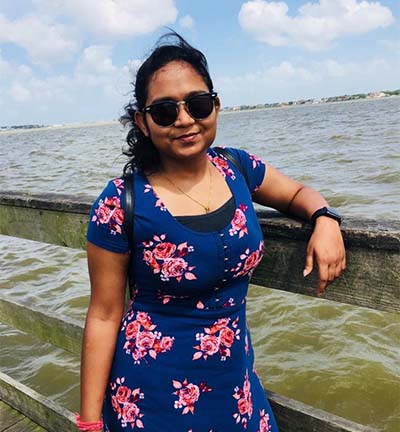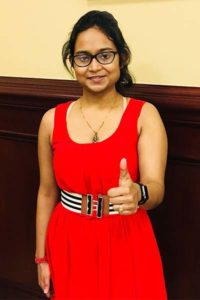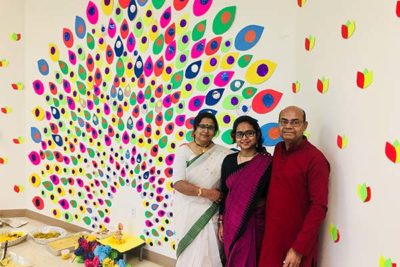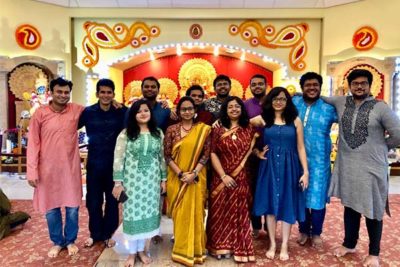This month’s Graduate Student Spotlight highlights Abira Sahu. A student in the Versaw Lab, Abira works on spatial distribution of inorganic phosphate in Arabidopsis roots. Learn more about Abira and her graduate experience in this month’s Spotlight below.
 Abira Sahu
Abira Sahu
I am a 5th year graduate student in Dr. Wayne Versaw’s lab. I grew up in Kolkata, India where I completed my education till undergraduate degree. I received my Bachelor’s degree in Biotechnology from Heritage Institute of Technology. During my senior year of undergraduate study, I worked under the supervision of Dr. Soma Banerjee and I studied antibiotic susceptibility of biofilm forming bacteria Staphylococcus aureus. I also did research projects in other institutes/universities during my summer and winter breaks. That’s how I gradually developed an interest in research and decided to pursue it further. I joined the PhD program in Department of Biology, Texas A&M University in August 2015.
For my PhD dissertation, I am studying inorganic phosphate homeostasis in cytosol of Arabidopsis thaliana roots. I use a FRET-based phosphate biosensor and fluorescence microscopy to monitor phosphate uptake, recycling and sequestration in live plants. I am also studying phosphate dynamics and distribution in root hairs.
 What is the best advice you’ve been given?
What is the best advice you’ve been given?
“Being happy is the ultimate goal of life. Everything else is temporary.”
What is on your bookshelf?
I am currently reading two books -The Secret Life of Plants and The Language of God: A Scientist Presents Evidence for Belief. Apart from these, there are obviously many biology and engineering textbooks (from undergrad) and notes.
What is one thing people would be surprised to know about you?
I love to draw cartoons in my leisure. They are mostly the ones I grew up watching. I also like cooking. When I first came to the US, I knew nothing about it and struggled to make my meals. Then I started watching recipe videos and gradually gained an interest in it.
 What characteristics do you prize most in a colleague?
What characteristics do you prize most in a colleague?
Honest, responsible and cheerful. I have to say that I was lucky to have always found such colleagues.
What advice would you give to a new graduate student?
Explore your options before you decide to join a lab. When I joined Texas A&M, I wanted to work in Microbiology. In spite of that, I rotated in a Plant Biology lab and ultimately joined there. I admit that it was scary at first but I ended up loving my research. I would have never known plant research can be so cool had I not rotated. Therefore, I would say be open, explore and you never know…you might discover a new interest.
 What projects are you currently working on?
What projects are you currently working on?
My project focusses on studying spatial distribution of inorganic phosphate (Pi) in Arabidopsis roots. We found a unique pattern in root developmental zones where Pi is highest in the transition zone. In my work, I used a FRET-based Pi biosensor to monitor Pi uptake, recycling and vacuolar sequestration in each root zone and identified that lower vacuolar sequestration is responsible for this unique Pi pattern at the root tip. Currently, I am studying spatial and temporal Pi dynamics in Arabidopsis root hairs.
 What is the broader significance of your research?
What is the broader significance of your research?
Inorganic phosphate is indispensable for plant growth but its bioavailability in soil is scarce. To circumvent this problem, farmers use Pi-rich fertilizers to boost plant productivity. This is both economically and environmentally unsustainable. Pi-fertilizers are mostly produced from rock phosphates which is a finite resource. Also, leaching of excess Pi from soil flows into water bodies and causes eutrophication which endangers the aquatic ecosystem. Therefore, the long-term goal of our research is to reduce fertilizer use and generate plants with high Pi-use efficiency.
 Why did you decide to pursue your graduate studies with the Department of Biology at Texas A&M?
Why did you decide to pursue your graduate studies with the Department of Biology at Texas A&M?
It was certainly the diversity of research that appealed to me. The labs in our department works on different topics in various organisms. Therefore, there are a lot of people to learn from. Moreover, the departmental seminars and SPRC are great to increase the breadth of your knowledge.
Also, being from a hot and humid region of India, I wasn’t ready to brave the cold weather of other US states (universities from where I had received admission offers).
What was a memorable experience at A&M?
Receiving my Aggie Ring. Getting through the prelims was the last hurdle before I was eligible to get my ring. Like everybody, my prelims were also stressful but fortunately I passed. I was elated when I could order my ring after that. My ring day was even more special because my mom was there to put it on me.



